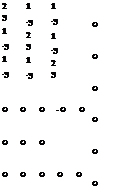elasticity symmetric tensor generally contains twenty-one non-zero distinct constants. When the material has some kind of symmetry, the number of these coefficients is reduced if the coordinate axes coincide with symmetry axes for the material.
In analyzing the mechanical properties of anisotropic linear elastic medium, a tensor of fourth rank is required to make up a linear constitutive relation between two symmetric second-rank tensors, each of which represents some directly detectable and measurable effect in the medium. The constitutive relation characterizing linear elastic anisotropic solids is the generalized Hook’s law as expressed in (1). Due to the symmetries in (2), the number of elastic coefficients is reduced from 81 to 21 which correspond to the most asymmetric elastic solid, namely, triclinic medium. The presence of symmetry in a medium reduces still further the number of independent elastic coefficients. For example, monoclinic symmetry medium (Tu. 1968) reduces the number of the non-vanishing independent elastic coefficients to 13, similarly, orthotropic to 9, hexagonal to 5, cubic to 3 and isotropic medium (the most symmetry) to 2 elastic coefficients.
The isotropic system has the well defined form invariant as following (Srinivasan, 1968):
C.., =A8 -8, +A8., 8. +A6. 8., (19)
ijkm 1 ij km 2 ik jm 3 im jk 4 ‘
where A1, A2 and A3 are constants, and later, Tu (Tu. 1968) has reduced the three tensors
into two basis elements. Following the same procedure presented in previous sections, the decomposition of C^m for the isotropic system is given in terms of the basis elements as:
C.., = I (C, T.k )T. k, (k = I, II)
ijkm k ijkm ijkm
k (20)
= (C, T^ )TI1 +(C, TI^
ijkm ijkm ijkm ijkm
where (C, Tk ) represents the inner product of C and the kth elements, Tk, of the v ijkm’ r r ijkm ijkm
basis, and
|
|
|
|
(21)
TII =–U8.8, (3(8., 8. + 8 8, )-28.8 )
ijkm 6>/5 ij km ik jm im jk ij km substituting these elements, then
C.., =—C 8.8 +
ijkm 9 ppqq ij km
1
—— (6C -2C )(3(8, 8 + 8 8, )-28.8 )
36(5) pqpq ppqq ik jm im jk’ ij km’
and in matrix form as:
 |
|||
|
|||
|
|||
|
|
||
|
![]()
K — c v 9 ppqq
1 1
G = (C _ _ c )
v 10 pqpq"3 ppqq
K^ and G^ are the well known Voigt average polycrystalline bulk and shear modulus,
respectively. Hence, the symmetric fourth rank elastic tensor of isotropic media is decomposed into two orthogonal terms. Equation (23) indicates that the isotropic symmetric fourth rank tensor, Cijkm, is a subset of the general symmetric fourth rank
elastic tensor, and decomposed into two terms, each of which has a distinct physical meaning, and the two terms are the same terms consisting the isotropic case. It is easily verified that the decomposed tensors form an orthogonal set, and their sum is the isotropic symmetric fourth rank tensor, C„km, which is identical to those found by Nye (Nye, 1959).
In fact, the above results are the same as those given in (Tu, 1968; Nye, 1959; Voigt, 1889; Radwan, 1991; Ikeda, 1990). Thus, it has been established that macroscopically isotropic elastic coefficients, which were obtained by W. Voigt, can be obtained directly from the procedure developed. Moreover, this procedure is valid for the most anisotropic triclinic elastic tensor.



